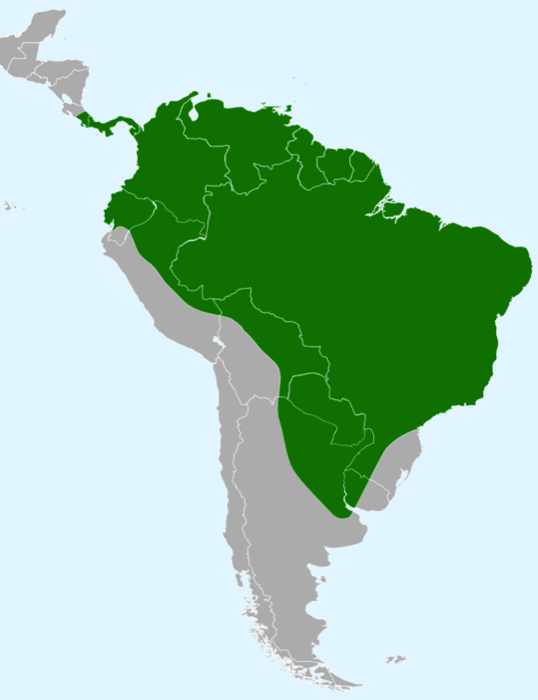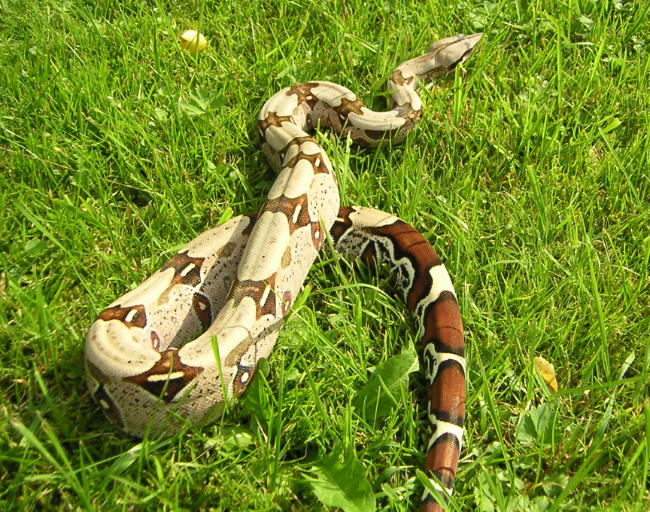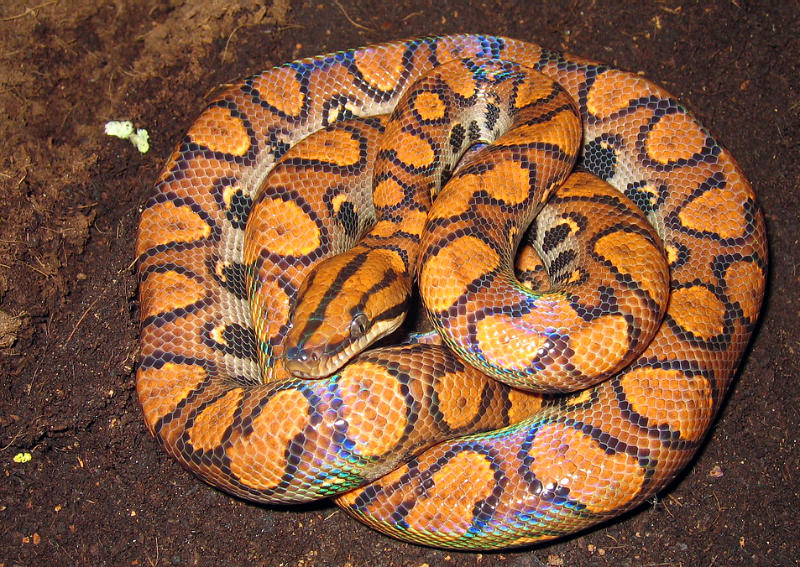Boa Constrictor
Boa Constrictor
Boa constrictors are some of the world's most recognisable snakes. Their large size, docile nature (in captivity) and lack of venom has resulted in them being popular pets. However, in the wild, they still deserve respect and should NOT be interfered with by Pantanal visitors. Although not venomous, they can still give a very painful bite.
Boa Contrictor
- Red-tailed boa, more commonly known simply as the Boa Constrictor, and
- the Rainbow boa. This is easily distinguished by its orange/black or chocolate skin with a sheen that refracts the light, demonstrating all the colours of the rainbow.
Red-tailed Boa
Rainbow Boa
Within the Pantanal, you're more likely to encounter the Paraguayan Rainbow Boa species, Epicrates crassus. This is has a dull red or chocolate-brown base colour rather than orange.
Scientific Name
Boa constrictor constrictor
Local Name
Jibóia or Boa
Description
Large heavy-bodied tan-coloured snake with dark saddle markings and reddish tail. Typically around 3 m in length.



Scientific Name
Epicrates cenchria
Local Name
Jibóia-vermelha
Description
Similar to the boa constrictor - but slightly smaller (2 m) and orange or chocolate-brown with light circular markings. Micro-ridges on the skin refract light creating an iridescent rainbow-like sheen.
The Red-tailed Boa ranges across much of South America, including the Pantanal. Other similar species such as Boa Imperator stretch up into Central America.
This map shows the range of Rainbow boa species. Besides Epicrates cenchria (which includes several subspecies of its own) this includes other related species Epicrates assisi, Epicrates alvarezi (Argentinian Rainbow Boa), Epicrates Crassus (Paraguayan Rainbow Boa) and Epicrates maurus (Brown or Colombian Rainbow Boa).
Behaviour and Habitat
Boas are sometimes found near water sources, such as rivers are streams - but generally still within proximity to woodlands rather than in wetland areas. Greater numbers can be found in the hills which surround the Pantanal region, and which are safer from seasonal flooding. Boas are semi-arboreal, spending much of their time among the lower branches of trees when young. But, as they get bigger and heavier, they're more likely to change to a terrestrial way of life - and often end up inhabiting the burrows of other animals. They occasionally also take up residence in areas near human habitation (or end up being kept as pets, including by indigenous populations) where they play an important role keeping the rodent population in check.
Boa constrictor, clearly showing why its also commonly referred to as the Red-tailed Boa. Credit: Embreus/Wikimedia.
Reproduction
With their generally bigger size, Boa Constrictors give birth to larger litters, which can range from 10 to 65, although around 25 is most typical. The litter size for Rainbow Boas is smaller - ranging from 2 to 35, but with around 20 also being typical. The young are 40 to 50 cm in length, and will usually have grown to around a metre by the end of their first year. As with the related Anaconda species, females boas seem to eat more and grow larger than males.
A Rainbow Boa (Epicrates cenchria) exhibiting its orange coloration, circular dorsal and lateral markings, with three parallel stripes on its head - and its unmistakeable iridescent rainbow sheen. Credit: karoH/Wikimedia.
Conservation and Threats
Quick Facts
- Boas are ovoviviparous. Young are born active and independent.
- Boa Constrictors reach up to 4 m in length, although this is rare in the wild. Rainbow Boas are smaller, only reaching around 2 m in length.
- In captivity, Boa Constrictors can live around 30 years, with some reportedly reaching 40. By contrast, Rainbow Boas live around 20 years. However, these longer lifespans are less likely in the wild.
- Avoid getting too close to wild boas, as they can be aggressive and strike quickly when provoked. They have sharp teeth which are designed to latch onto prey and hold it until the snake can manoeuvre it's coils around it. This means that the boa's bite can draw blood and be very painful. This can be avoided if you keep a safe distance and do not interfere with the snake.
- Young boas can be aggressive but, if raised as pets and accustomed to people, they can be docile and will very rarely attack.
- Boas aren't aquatic like anacondas, so are rarely encountered within the wetlands. But they can be found in dryer woodland areas, and in hills bordering the Pantanal region.
- Boas are usually nocturnal, coming out at night to hunt small animals, such as birds and rodents.
- When frightened, boas can emit a shrill whistle by emptying all the air in their lungs. The sound is used to try discouraging predators from approaching.
Banner image: Boa constrictor (Shutterstock/Roy Palmer)



